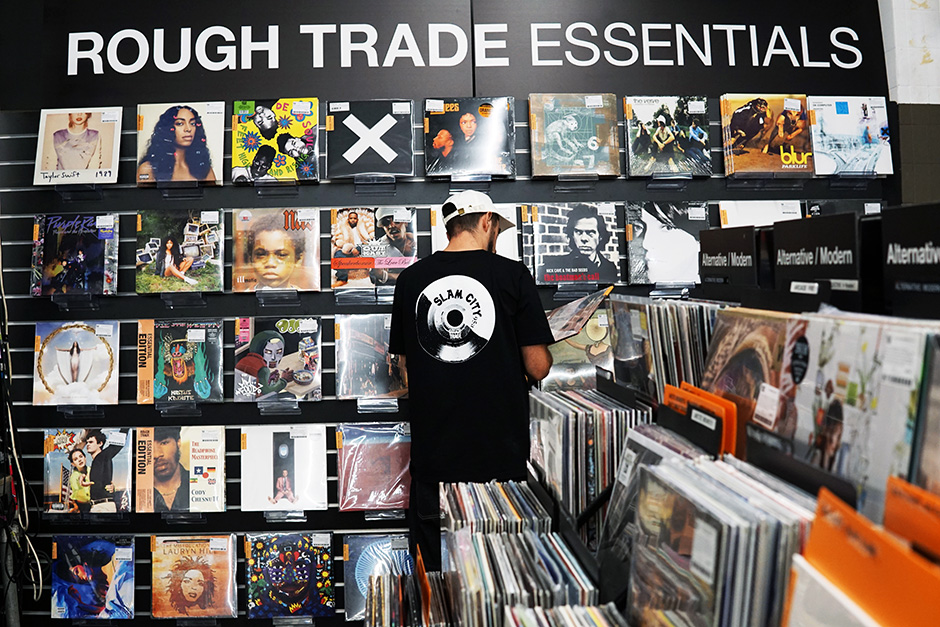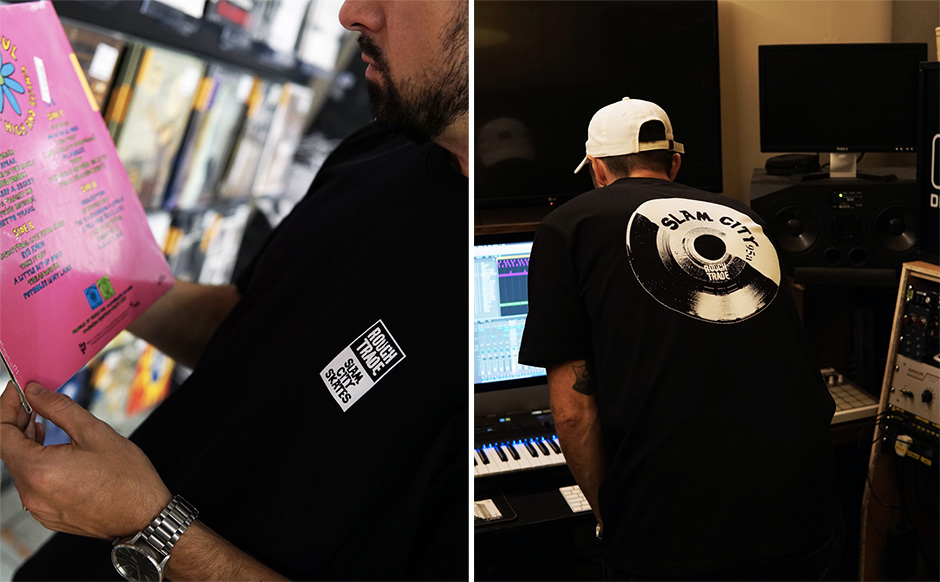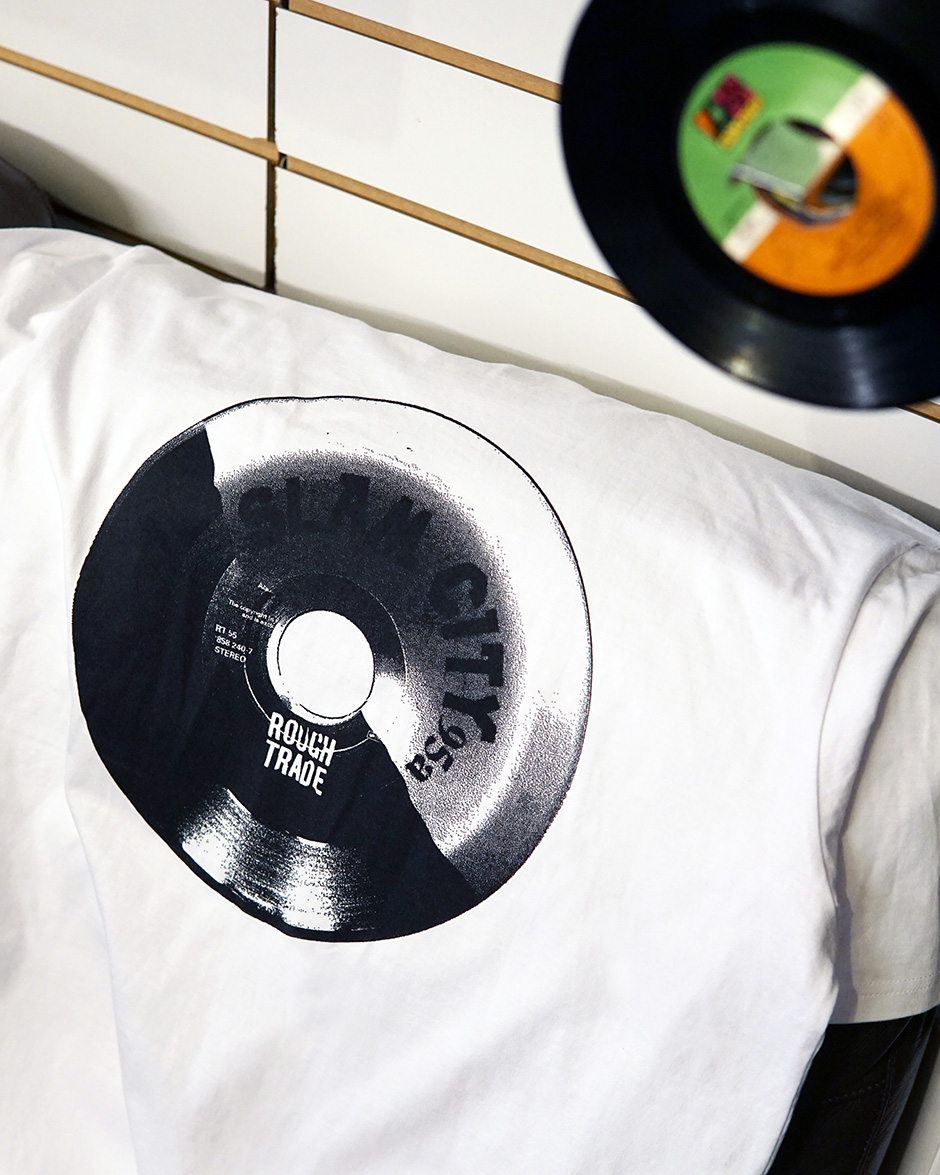Fergus Purcell is an old friend of ours with deep ties to the shop you will learn more about through the course of this interview. Fergus is an artist, a graphic visionary whose work has been resonating with an evergrowing audience since his very first job for Slam in the 80s. Even if you have only just heard of Fergus, his work precedes him. He designed the Penrose triangle graphic for Palace Skateboards when they first started and has likely been the mind behind many graphics on your radar. It was often said that if someone were to find one of the sketchbooks he would always travel with, they would have enough fuel to sustain a T-Shirt company graphically for many seasons. The inimitable, consistent genius that he filled those books with has led to many collaborations. We are beyond happy to be the latest on that list, Fergus is the graphic conduit who has commemorated our historic relationship with Rough Trade records on our latest T-Shirt release.
As soon as we knew the T-Shirt collaboration with Rough Trade was to become a reality, we wasted no time in reaching out to Fergus. His love for Slam and Rough Trade is something we had spoken about before, and very soon afterwards his graphic, which marries a skateboard wheel with a 7” record, illuminated our inbox. We are proud to have released this shirt and have many happy memories of coexisting with Rough Trade over the years, it’s poetic that we are still a stones throw away from each other.
This interview with Fergus celebrates times past, his personal history, and the upstairs-downstairs nature of our evolving relationship as businesses, but also recognises the magic both shops retain for anyone walking through the door for the first time.
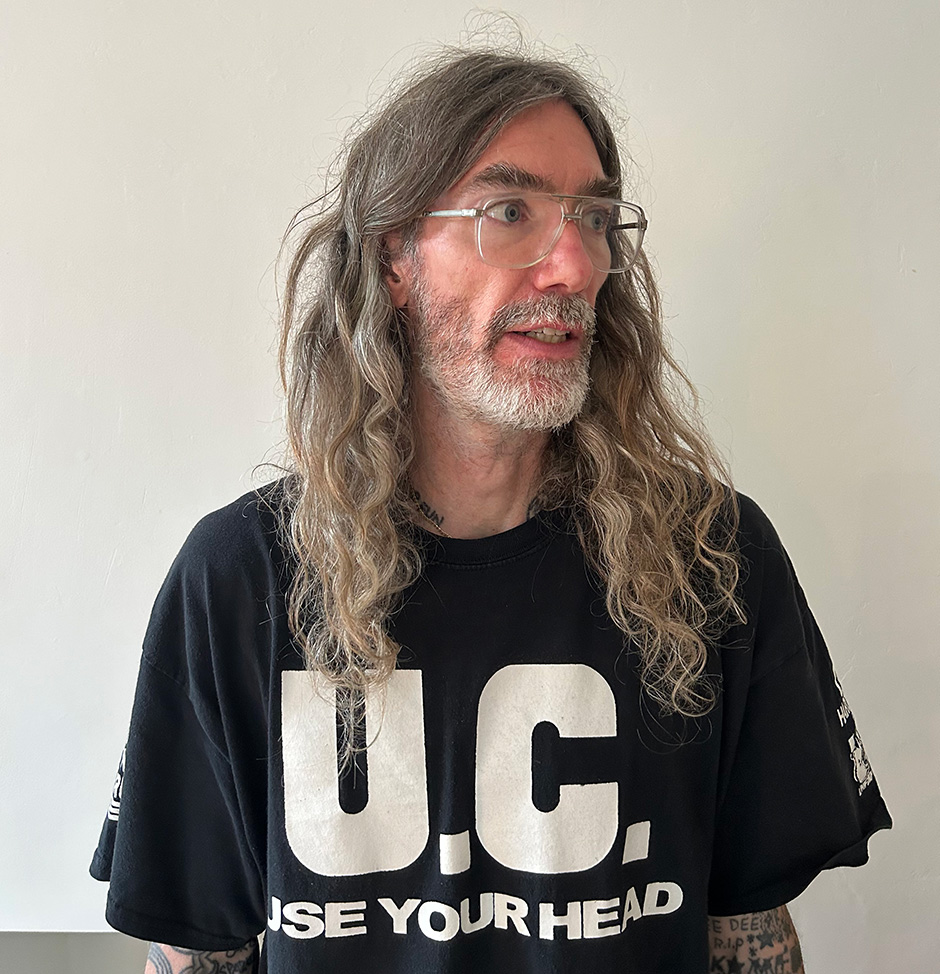
Words and interview by Jacob Sawyer. Fergus Purcell at home. PH: Matty Snow
Do you remember the first time you visited Slam?
Yeah I do, I had already done a piece of artwork and sent it in. At the time I was living in a place called Chesham. It’s at the end of the Underground so it’s not that far away but it meant that the first thing I got from Slam I actually mail ordered. So I didn’t meet anyone, but on the letter I sent for the mail order were loads of drawings I had done, I’d doodle on anything at that point. They responded saying they really liked the drawings I had done and sent me loads of ‘Skateboarding Is Not a Crime’ stickers. They asked me to do some artwork prospectively for a T-Shirt. I think I sent them that in the post and then I visited the shop so the whole visit had this quite epic quality.
I was really shy and almost intimidated even though I had never been there. It wasn’t as if I had heard anything about the shop, that it had that reputation, or that it was a daunting place to visit, or the staff there were hardcore. It was nothing like that, it was just in my own head, it was this big deal. I was really antisocial, I was still at school at that point and I hated school. I wasn’t in a scene and I wasn’t in any kind of group which is why the skating thing appealed to me so much. It seemed outsidery and it was something you could do by yourself, so even my approach to Slam was in that mode of being quite outside of things, even outside of the Slam City thing. I got my courage up, I phoned them up, and I went in there to go and say hello.
Who did you go and speak to?
Paul [Sunman] was there and a guy called Iain [Baker] who was in Jesus Jones. This was when Slam was in the basement of Rough Trade at Talbot Road. I turned up there on a week day because I think I had bunked off school. That meant it was really quiet, it was just me which was nice, but I was astonished because when I went down there they were watching Neighbours, hahaha. My thing was that I was going to this epic location of subculture, an amazing thing in my mind but I turn up when they’re busy watching Neighbours, pretty classic.
So that would have been about 1:30 in the afternoon.
There you go, exactly, that nails it. They were really friendly after I kind of nervously introduced myself. I think for a second they may have thought “what the fuck are you talking about?” but they must have been used to all sorts of grommets turning up. They were really nice to me and that was it
So that day was also your first Rough Trade visit?
Yes that’s right, the two things were kind of as one. I initially discovered skateboarding through music by coming across bands like D.R.I. and Celtic Frost who were affiliated with it at that time.
Was there any kind of record shop hub where you grew up?
At that point I didn’t have a record player, I just had a tape player. I would just get people to make me tapes of stuff so I had being listening to all this kind of stuff second-hand from whoever had the album. I was part of that network. I had been to the High Street record shop and I was fascinated by all the covers. I would buy new tapes occasionally from somewhere normal like Our Price. I started to discover weird music before I discovered the places where you bought weird music from, if you see what I mean. Rough Trade would have been one of the first places I would have gone in that was part of that world, and I quickly got stuck in.
“I started to discover weird music before I discovered the places where you bought weird music from”
Iain [Baker] in particular was really friendly and because he was into loads of different music he would make recommendations, he would tell me I had to listen to Hüsker Dü for instance. Then I would just go upstairs and get the Hüsker Dü album.
Jesus Jones were a great band too.
Yes, absolutely. That was another thing that was kind of a piece of the puzzle and why I was drawn to Slam City Skates in the first place. There was something cultural that was going on, and it was plugged into this weird nexus of skateboarding, music, and to some extent you would have to say fashion. Both shops sold clothes and at that time those clothes were really trendy.
All those bands were wearing skate clothes.
Exactly, Acid House had begun and those clothes were adopted by those people too in some regard. It was part of this wider, interesting conversation, and that’s probably why I got really embedded in it. In fact, if it had been more of what would now be called a core skate thing, I wouldn’t have related to it as much. There was something really happening in the zeitgeist and Slam City was this bridge between all of these different things, I just found that irresistible. That’s why it’s so meaningful to me and why I got involved in the first place.
“There was something really happening in the zeitgeist and Slam City was this bridge between all of these different things, I just found that irresistible”
Also the gods at that time for somewhere like Slam City would have been the Gonz and maybe Neil Blender. So it was that side of skateboarding, the arty, weirdo side of things rather than the hessian, jock side of things. So again, there was a place for someone like me within that mix for how important the visual side of things were.
So much diverse visual information in one building, all the way through to zines and books.
Totally. Upstairs in Rough Trade or downstairs in Slam you would also see minor celebrities of the time whoever they may have been. So there’s this whole other strand coming into it who were drawn in. Rough Trade was so important in that Post-punk movement, the ripples from that went in so many directions, including into the pop charts. There were quite a few Top 40 bands that had essentially been part of that West London Post-punk scene. It was intriguing, there was this slightly older generation present who were really good people to rub up against, a really good influence.
From board wall to record wall. The Slam City Skates x Rough Trade shirt in front of some essentials
I was blown away by how quickly you came back with the graphic when you were asked to do this, were you?
I usually tend to work quick. I like that fresh burst of energy with a new project, I find that really exciting and often quite a resolved visual idea will pop into my head. I’m open to developing things and exploring visual ideas but often if I have an idea already I’m keen to get it down on paper so to speak and do the finished artwork. In a professional sense I really take pride in trying to do a good job and get things to people quick. So this graphic was fairly normal procedure for me but with you guys asking, that’s more of a special thing. I didn’t have many believers for quite a long time. Those who were there early on get a bit of special preferential treatment, and Slam City were the first. There you go, this project deserved and needed special attention and even now it’s so meaningful with what I’m doing. We were speaking earlier about the work I do for Palace Skateboards, it’s obviously absolutely the roots of why I’m doing that.
So it’s often first thought, best thought for you when approaching a project?
That is often the way, it’s helpful to not have that as a rule though and be able to step past it. Speaking professionally I will often think something is the best thing, then I’ll send it to people and they may not. So I have to be able to step past my first thought. When working freelance that is very much part of the process, being able to rethink and direct the same energy to a new idea. But generally I do find my initial instincts work best.
A wheel and a record label are small constraints to work to. What wheel graphics made an eternal dent on your young psyche?
All the Santa Cruz stuff when I first got into it, that’s what really grabbed me. I really liked what Powell Peralta did but I related more to Santa Cruz on a visual level. I was super into comics and by that time I had discovered underground comics. I was looking at a lot of sixties artists like Robert Crumb, Spain Rodriguez, and Gilbert Shelton. I found the Santa Cruz vibe very resonant of that so I was instantly drawn to the chaos, the slime, and the whole aesthetic.
Being into that world, and being into graphics, the two wheels I would mention would be Santa Cruz Slime Balls, and Bullets. Slime Balls had that gooey, too much information, busy style, very much not graphic design. They were ugly beautiful, bad taste basically, which I always really liked. On the other hand the Bullet graphic of the time was very clean and aggressive. It was a one colour graphic and it had the bullet on it with the whizz lines going circularly around the wheel. Those two sum it up, I liked the hard-edged aggressive graphics as much as I liked the more comic book inspired crazy, busy kind of thing, Santa Cruz had it covered. How much time have you got though? There are wheels, and wheels, and wheels, hahaha.
The Slam City Skates x Rough Trade Inverted T-Shirt in the wild. From the Rough Trade shop to the studio
I guess a lot of people would have first hit on Powell Peralta or Santa Cruz. After that you just picked up a copy of Thrasher and it was full of all of these other things. It was such a rich, incredible visual language. G&S had such a different voice to Vision, so did Skull Skates, and so on. That was very striking, although it was a particular scene there were all of these distinct visual voices with their own kind of visual language. I clicked into that really quickly, I only consumed a certain amount of that, but in terms of what I looked at, enjoyed, and liked it would have been all of it. At the very start I would have been very undiscriminating about what was a cool company or a cool team. I was just looking at the imagery, all of it, whether it was Lake Skateboards or Schmitt Stix. It all just looked incredible to me.
I guess the wheel graphic takes all of that information and condenses it, the Jim Phillips chaos is boiled down into something small and symmetrical.
I really like that thing, and it’s the same for the constraints of a board shape, it becomes a format like a T-Shirt or a fanzine. It’s a set format but within these quite defined parameters anything can happen. That’s quite a graphic design or commercial art proposition, you have a set template, what can you do with it? The wheels sum that up, and the notion goes for decks as well, the graphics somehow were really important but utterly disposable because they just get scraped off. That was wild, that didn’t apply to anything else. People would lovingly paint a hot rod car and that would be a pristine paint job for a lifetime. Even a printed T-Shirt, as much as it may fade and get worn, the print remains.
“the graphics somehow were really important but utterly disposable because they just get scraped off…There was some kind of danger in that, or threat. That non-preciousness was really cool”
Skateboard graphics were really transient and there was something about that. For me, someone who loved graphics and found them really important, that was so exciting. There was some kind of danger in that, or threat. That non-preciousness was really cool. When you think about it, why do skateboards need graphics at all? They’re on the underneath of them. They are super important but they don’t really need to be there, pretty cool, and it’s the same with the wheels.
What about record labels, which ones were impactful?
I’ve got to put my hand up and say I was a huge Prince fan. Having talked about that Post-punk thing, in the 80s in the mainstream there were all of these weird, edgy things readily available. I didn’t make the distinction between Warner Brothers records and something with more of a cult status. I absolutely loved how Prince had this Paisley Park Records imprint that existed within this big mainstream framework. Then I suppose straight away I took a sidestep when I started getting into Slam stuff, the record label that really made an impression on me would have been SST. They would take out substantial ads in Thrasher and there would be these thumbnail images of all the different artists. They had Dinosaur Jr, Sonic Youth, Hüsker Dü, and Black Flag as well as all of the other stuff. Those bands are huge, so influential, So maybe that would be the label. I have to say I wasn’t buying records at that time, I was buying cassettes. I think Black Flag Live ’84 was the first SST release I got on cassette.
Read the label and say it loud. The backprint of the Slam City Skates x Rough Trade Lo-Fi T-Shirt
The spine of the cassette was another small space that transmits a lot of information, a wheel equivalent.
You’ve nailed it, it’s that set format, the inlay in the cassette. That was more of a pointer for me that commercial art was this amazing place where one could express their own personal artistic temperament as much as you wanted within that. I was always very drawn to that side of things as opposed to feeling I was a fine artist, or needed to paint on a canvas. I’m not putting that stuff down at all, it’s obviously amazing but I knew that I would never feel restricted by a T-Shirt, or a record cover, or a skateboard, or a wheel, or anything else I may be lucky enough to get to do. I still love the formal restrictions of those shapes and those templates
Was there a specific wheel in your mind that made you choose the 95a Durometer?
It was plucked from that era. I thought with the proportions of the wheel that I needed to use that would match up with a disco-middle 7”, it needed to be 80s-esque. Without getting too nerdy on the specifics, that’s why I put that on there. I wanted to add a durometer to reinforce that it’s a wheel too.
So your first ever paid work was commissioned by Slam. What was the first thing you did?
Something I drew was going to be used for a T-Shirt or a hoody but was maybe never used. The other thing I did that was used is very appropriate to this because it was for both Rough Trade and Slam. It was an advert that appeared in Viz comic. I was already a big fan of Viz so that was ticking all of the boxes, I couldn’t believe it! I got a ‘Battle of the Eyes’ Slam City hoody as payment for doing that advert. Then I did something shortly after that where I did get a cheque, which I wish I kept.
What Slam imagery had inspired you before that?
I loved that whole ‘Battle of the Eyes’ thing. It was Chris Long, Savage Pencil [Edwin Pouncey], and Ian Wright. I was aware of all of their work so I loved it when I discovered what ‘Battle Of The Eyes’ was. I thought it was one thing and then quickly discovered it was these three individuals. It seemed so mysterious and intriguing so that was inspiring. From all of that there was a carrier bag graphic Savage Pencil did which said “Kiss Our Patch” with the map underneath. That was just so kind of raw, and amazing. That stuff just wasn’t really out there in the public domain if you did look.
It’s hard to believe now because we live in such a visually rich landscape. We’re now used to seeing things that would have been considered outrageous. What was outrageous then is now a normal thing for a High Street brand but then it didn’t exist. They were genuinely strange voices from a subculture and therefore the look of that would really jump out at you. Of those three guys it would be Savage Pencil I was most aware of and looked up to. He had done stuff for Sonic Youth, he had worked in comic books quite a lot, and his look appealed to me most at that time because it was outrageous and filled with a teenage energy.
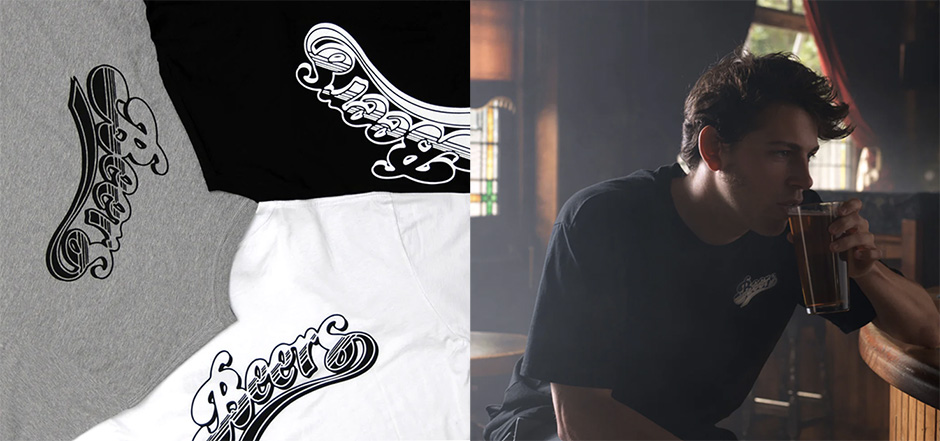
Fergus designed this ‘Beers’ T-Shirt inspired by a Boston-based sitcom for Slam’s 25th anniversary
Do any events that went down at Slam and Rough Trade stand out in your memory?
Soon after I got involved they did an event at a club on Charing Cross Road called The Limelight, it had a mini ramp in it. So I went along to that and it was really exciting, all of these skateboarders descending upon the venue. This was before I was a clubber so it was new to me to go to something like that, I went by myself. But jump ahead a few years and I have to say that the real stand out moment was when the Beastie Boys played in Rough Trade in the basement below Slam at Neal’s Yard in 1994. I was very lucky to have witnessed that, it was really something.
How important do you feel it is that both of these stores are still standing, and still in close proximity?
It’s really great because it shows that energy is still relevant, and the cultural topics they were touching on are still valid. It’s also cool that it has its own new life. I hope that what I have done speaks to people in their own way and isn’t just an exercise in nostalgia. It’s a vintage wheel, things from the 80s are vintage now, but I’m not on a nostalgia trip with any of that stuff. I’m not saying what I experienced is in any way better than it is for some kid walking in there tomorrow for the first time.
“I’m not saying what I experienced is in any way better than it is for some kid walking in there tomorrow for the first time. To me that’s the special thing, there are still these opportunities for it to be meaningful”
To me that’s the special thing, there are still these opportunities for it to be meaningful. The same with Rough Trade, they’re playing music in the store and some kid walks in and says “what’s this?”, that’s what is exciting to me. Then someone takes that experience and does whatever with it in their life, that’s the cool thing, not how it has influenced me. For me it turned out to be such a door into this whole other world. Both shops will continue to be that for different people in all sorts of different ways, that’s very cool.
Within the realms of skateboarding and music is there anything new you’re getting a kick out of?
I am always a bit behind, I think the new thing I’m going to mention is two years old now or from last year. There’s band called Blood Incantation who have been know for their death metal stuff but it turns out they are huge krautrock, synth fans. They released an album in that mode instead and it’s called Timewave Zero. I’ve only just come across that but I’ve been enjoying listening to it. With skateboarding I always love seeing what Lev [Tanju] is up to and as far as something new I think Ville [Wester] is an amazing new addition to the Palace team. He is so incredible, and styley, and I love watching him. Also seeing as Palace just came out with Beta Blockers I love that Jahmal [Smith] had a bit of a longer part in that, I love his skating, and his unique style.
What graphic that you have designed were you happiest to see on a skateboard?
That’s a good question. I did a Volkswagen GTI graphic for Palace. It was done in an airbrush style, super realistic, super slick, glossy, and very high finish. When the Palace office was in the basement of Slam in Covent Garden at the Endell Street address, somebody popped in who had been skating it, and it was fucked. It looked so good that I took a photo of it. It was that contrast, that’s my favourite time where I have seen a graphic I have done in use, it was half gone. That slick thing mixed up with the slid up wood laminates, what a cool thing to see happen to your artwork.

Fergus Purcell’s GTI graphic for Palace Skateboards before and after
Did you enjoy the time you spent working beneath Slam over there?
Yeah, it was super good energy, and a direct tap into all of the stuff we were talking about. You’re in this physical proximity to what’s going on. There was also that upstairs-downstairs relationship. I’m sure you have loads of funny stories and anecdotes about Slam and Rough Trade, I know you do, I’ve read them. There was this really funny, weird interface between the two different worlds, being on two different levels. Even how that inverted and swapped when Slam moved initially from Talbot Road to Covent Garden in 1986. There was always that thing of how someone had to walk through the top floor to make it to the basement.
In Talbot Road the skaters had to walk through the music nerd thing to get downstairs to the skate shop, and in the Neal’s Yard shop the music customers had to get a hazing from all the skaters before they got downstairs. It felt very much a part of that, the same funny relationship, which I really enjoyed. Also it’s very healthy to be close to who your customer is and to feel that energy, and for it to be non-hierarchical. Just because we’re making the stuff doesn’t make us above or better than anyone who is enjoying it, and consuming it. Breaking down that hierarchy is healthy and really good. Having that relationship, and arrangement, did that.
What’s the most played record you have bought from Rough Trade?
Over the years it might be that Hüsker Dü record that Iain [Baker] put me onto. It would either be that or the Black Flag Live ’84 album. Ironically the Hüsker Dü album is from when they broke from the indy label and signed to Warner, funny right? It’s from that year and it’s called Candy Apple Grey. They’re the two I have sat with the longest and still listen to.
Last words?
Thanks for reading. I’m so lucky I got drawn into this thing, it’s almost like I didn’t have a choice. I’m happy to be involved, and very lucky that people would have me, I still feel that way. It still influences the look of my stuff but more than that, it influences how I approach my work. I’m very influenced by that rootsy, DIY, start your own record label, make a fanzine kind of approach. That’s still how I operate. This whole thing has been a huge influence on me so thanks to anyone who reads this.
The Slam City Skates x Rough Trade Inverted T-Shirt on the back seat of the studio
We would like to thank Fergus for his time and for designing an amazing graphic that celebrates our shared history with Rough Trade records. Be sure to visit the Rough Trade Blog to read their take on this collaboration. Shop with us for the T-Shirts or pay either of us a visit by coming to our East London store.
For a deeper dive into our shared history read Skate Shop Day: A Slam City Timeline from 2022.


